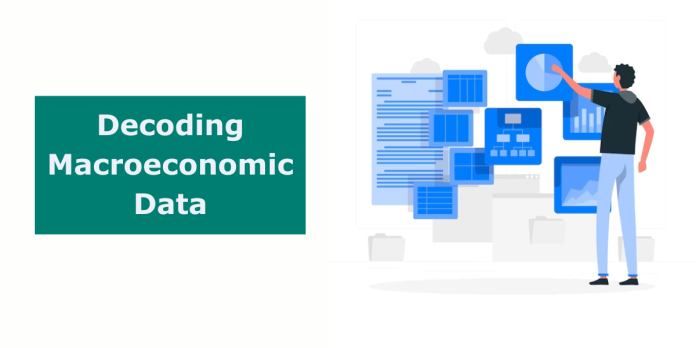Ladies and gentlemen welcome to the fascinating world of macroeconomic data, where a dizzying array of close to 100 data points emerges every month, leaving investors in a state of bewilderment. These data releases vary in terms of frequency and the time period they represent, adding layers of complexity to an already intricate landscape. For instance, when you see inflation data released in October, it’s actually reflecting the inflation figures from September. Meanwhile, the Index of Industrial Production (IIP) released on the very same day is all about what happened earlier. It’s no wonder that this deluge of data often leads to the burning question: will it shake up the markets tomorrow? But before we tackle this question, let’s take a step back and demystify how we can read and make sense of this sea of information.
At its core, the macroeconomic world revolves around a simple equation: GDP = C + G + I + X. In this equation, “C” represents private consumption (yes, that restaurant meal you enjoyed last weekend actually counts), “G” stands for government expenditure (encompassing everything from public salaries to government-funded projects), “I” signifies investments (from both private and public sectors, such as the house you’re building or the road the government is constructing), and “X” represents net exports (the imported Scotch minus the exported bedsheets).
Whether you’re a newbie in economics or a seasoned expert, this framework is the foundation for understanding how an economy functions. It enables us to categorize those numerous data points into four broad categories and explore them in depth.
The intriguing part is that despite the seemingly quantitative nature of this data, the insights it provides can be surprisingly qualitative. The same set of data can paint a different picture for different individuals, and that’s perfectly fine. Economists are known for their skepticism, where one person might find excitement in credit growth while another dismisses it as primarily driven by small and medium-sized industries, with limited overall impact. Similarly, someone might fret over high inflation, while another might attribute most of it to rising commodity prices.
In essence, interpreting the same data differently is what makes us human.
As a general rule of thumb, it’s essential to assess the month’s growth compared to the past 12 months, account for unusual base effects, and consider any known one-off events. Now, let’s start categorizing these indicators:
Private Consumption: This category focuses on indicators that shed light on consumption and demand. Keep an eye on consumer sentiment, personal loans, and automobile sales. Also, consider non-POL imports, retail inflation, and total retail payments.
Investments: The investments category encompasses various indicators such as OBICUS (capacity utilization survey), credit to the industry, and production in key sectors like steel, cement, and coal. Additionally, keep a close watch on household investments and government capital expenditure.
Government Consumption: This is perhaps the most discussed component. Monthly revenue sources like GST, e-way bills, tax collections, and government expenditure offer early insights into the fiscal health of the nation.
Net Exports: Analyze trade data, including trade deficits, oil deficits, and exports/imports of major commodities. This helps gauge the impact of global narratives on India’s trade.
Capital Flows: Examine foreign institutional investments in debt and equity, foreign direct investments, and external commercial borrowings. This provides a comprehensive picture of the balance of payments.
Now, for the million-dollar question: will the markets react to this data? The straight forward answer is “NO”. Markets operate based on expectations rather than data releases. However, understanding the data allows for more informed expectations, which, in turn, enhances investment strategies. After all, a grasp of historical data is crucial to comprehend the future. So, while the macroeconomic data jungle may appear daunting, navigating it with the right perspective can lead to valuable insights and sharper investment decisions.
In conclusion, don’t let the sheer volume of data overwhelm you. Instead, embrace it as a tool to sharpen your investment skills and shape your understanding of the ever-evolving economic landscape.
Know more:


